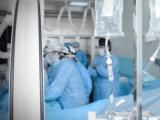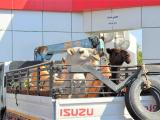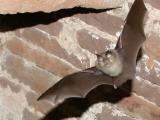With few data available, experts are at a loss to explain the rising tide of MERS-CoV (Middle East respiratory syndrome coronavirus) cases in Saudi Arabia and the United Arab Emirates (UAE). But when it comes to speculation, two leading possibilities mentioned are a change in the virus and a seasonal pattern to its transmission.
Saudi Arabia has reported more than 100 cases since the beginning of April, many of them in a healthcare-related outbreak in the Red Sea port of Jeddah. The number of recent cases in the UAE, meanwhile, is unclear but seems to be well above 25, including 14 that, according to the World Health Organization (WHO), stemmed from one healthcare worker (HCW).
In a statement today, the WHO noted that about 75% of the recent cases are secondary ones resulting from human-to-human transmission, with the majority occurring in healthcare settings, often in HCWs. Acknowledging "critical information gaps," the agency said it is unaware of what specific kinds of exposures have sparked the cases in healthcare facilities.
Experts are quick to emphasize that very little is known so far about the outbreaks in Saudi Arabia and the UAE, making it impossible to reach any conclusions about their cause as yet.
"These cases are just being reported and information regarding them is trickling in to WHO," said David Swerdlow, MD, leader of MERS activities at the US Centers for Disease Control and Prevention (CDC). "As we learn more, we can get a sense of the nature of these newly reported cases. For example, is this just seasonality, an increase in cases because of a hospital outbreak or a change in the efficiency of how the virus is transmitted?
"At this time, there is no conclusive indication the virus has adapted enough to sustain human-to-human transmission, something CDC is monitoring closely," he added.
Possibility of viral evolution
Allison McGeer, MD, a microbiologist and infectious diseases consultant at Mt. Sinai Hospital in Toronto, agrees that there is too little information to do more than speculate for now, but she sees some signs that suggest the possibility that the virus is changing. She was part of a team that traveled to Saudi Arabia last year and advised the government about its response to MERS-CoV.
In an interview, McGeer, who led efforts to stop the SARS (severe acute respiratory syndrome) coronavirus outbreak in Toronto in 2003, compared the Jeddah outbreak with the outbreak in Al-Ahsa (also written Al-Hasa) in eastern Saudi Arabia a year ago. That one involved 23 confirmed and 11 probable cases in several hospitals, according to a June 2013 report in the New England Journal of Medicine (NEJM).
McGeer said that although information is lacking, the Jeddah outbreak "seems like a multi-institutional, really complicated outbreak. . . . It's clear that there are a substantial number of healthcare workers involved."
But the two outbreaks, she said, seem to differ in at least one way: "Compared to last year, the attack rate in healthcare workers appears to be higher, and I don't think that that is related to more testing. One of the striking things about the Al-Hasa outbreak was that the attack rate in healthcare workers was relatively low compared to the rate in patients.
"This ratio of healthcare workers to patients looks different now, and that raises the issue of whether the virus is changing," she added. "To me that's the critical issue that needs to be answered."
A spring thing?
Connie Savor Price, MD, chief of infectious diseases at Denver Health and Hospital, speculates that there may be something about MERS-CoV that makes it spread more readily in spring.
She noted that the first known outbreak of MERS-CoV occurred in a Jordan hospital in the spring of 2012. (The virus had not yet been discovered at the time, but months later, analysis of stored clinical samples revealed that MERS-CoV was the cause.)
"Of course I'm going on a really, really limited number of outbreaks, but, among the larger healthcare outbreaks: Jordan hospital outbreak peaked in April, as did Al-Hasa outbreak, and now we have this recent activity in Jeddah," Price told CIDRAP News.
Further, she observed that SARS, another coronavirus, peaked in March and April of 2003 and was largely gone by summer.
"[I'm] still perplexed why no one got sick at Hajj last fall," she added. "Perhaps spring is special for MERS. We do know that other coronaviruses have a marked winter/spring seasonality."
"That's just one very theoretical idea," Price cautioned. "Without detailed information on the recent Saudi cases, it's really hard to do anything but guess. One could imagine it's a combination of factors—in addition to the theory above, sheer lack of data on transmission to guide best practice, infection control lapses, super-spreaders, evolving virus becoming more fit to spread human-to-human. We could guess endlessly."
McGeer also mentioned the possibility of a seasonal pattern to MERS-CoV transmission. She speculated about one possible contributing factor. Recent studies have indicated that MERS-CoV is fairly widespread in camels on the Arabian Peninsula, and it seems to be more common in young camels than adults. She noted that camels usually give birth in spring, which means a higher population of young camels at that time of year, perhaps raising the risk of human MERS outbreaks.
German virologist Christian Drosten of the University of Bonn hinted at the same possibility in a news story in the Mar 28 issue of Science. He said young camels may contract MERS shortly after birth and be in their most infectious condition in the spring.
Infection control issues
But even if there were a known seasonal aspect to MERS transmission, it wouldn't explain why the current outbreak in Jeddah is so much larger than the Al-Ahsa one a year ago, said McGeer.
"The Kingdom of Saudi Arabia has perfectly good infection control practices, they know how to do that well, they did a great job with Al-Hasa last year, yet this outbreak appears to be substantially larger than Al-Hasa was," she said.
"So how this virus got past what I think generally are competent infection control people and caused a larger outbreak than was seen last year, I think really raises an issue about whether the virus has changed," McGeer added.
Another possibility that some have mentioned is the emergence of "super spreaders," meaning infected people who spread the virus to many others. The UAE MERS patient who infected 14 others appears to be in that category, and one patient in the Al-Hasa outbreak was believed to have infected seven others.
McGeer said it's theoretically possible that a super spreader is a factor in the Jeddah outbreak, but she thinks it unlikely that that would explain all the cases, because that would seem to require several super spreaders, not just one.
Research badly needed
One way to help figure out if the virus is changing is to get a MERS-CoV sample, sequence its genome, and compare it with earlier isolates. But McGeer said, "Nobody's seen any 2014 isolates."
Noting that cases were identified last week in Greece and Malaysia, she expressed a hope that isolates from those patients will be sequenced.
The CDC's Swerdlow said in response to a question, "We are working with our partners to obtain [MERS-CoV] samples for sequencing."
Price voiced what is probably the view of many observers of the MERS-CoV landscape: "We need to stop guessing, get all hands on deck (ie, international collaboration), and do a detailed outbreak investigation with case-control study, complemented by genetic sequencing data to understand what is happening. This should be doable right now."
See also:
Apr 23 WHO statement
Jun 19, 2013, CIDRAP News story on NEJM study of Al-Ahsa outbreak


















